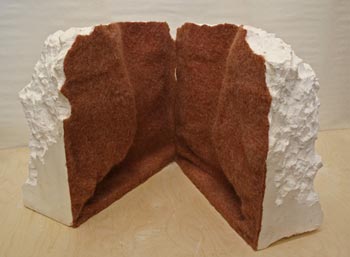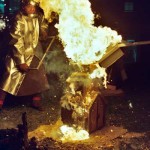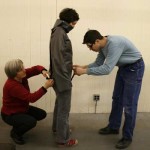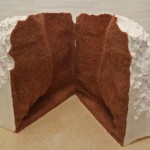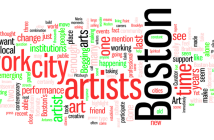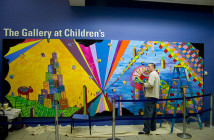What does it mean and why did you make it? What is the origin of this piece? Have you ever been to an artist talk and, instead of admiring the artwork, found yourself marveling at how the artist's statements and descriptions can be so substantively vacuous yet be so verbose and even effusive? The artist may believe that the work needs a description or story to legitimize or validate it, but perhaps the artist does not even know how to describe his/er work.
Véronique d'Entremont, the current Artist in Research (AIR) at the Berwick Research Institute, doesn't bother trying to answer those questions while she creates her work, sometimes she won't even know those answers until long after the work's completed and the show's been taken down. She makes the work to help her answer the questions themselves and she is not too bashful to inform anyone that she hasn't yet been able to resolve a piece's meaning to her. The work she is currently making during her time in the AIR program is the product of the last several years of her life, in which she experienced one bout each of serious psychological and physical traumas. The wounds she suffered have been the source of much of the work she produced over the same time period and each of those pieces offered her a chance to realize a hidden emotional scar left behind from those past events.
I had the pleasure of meeting Véronique in 2001 when she was still a precocious and standoffish teenager. Just this past July at her artist talk at the Berwick, after not having seen her in five years, I approached her with some trepidation, expecting my ego to be bruised by a patronizing quip in response to any question I had about her work. Luckily for me, she's softened up some, however, unfortunately for me, her somewhat acerbic sense of humor is still there. I was caught off-guard during our interview last week when she subtly jested, "Are you saying that my art's a lie?" after I asked her several questions in trying to understand her art's foundations. Despite this line of questioning, however, we spent a lot of time discussing what we should actually talk about during the interview.
D'Entremont is similar to the previous Artist in Research at the Berwick, Kelly Sherman, in that they both produce work that helps them articulate and cope with their emotions.
Though this could be a reflection a partiality on the part of the Berwick's AIR curatorial staff, it's not as though it's hardly an uncommon or obtuse method of making art. Finding the words to articulate one's emotions is a fundamental step to understanding them, yet reaching a point to where those words are recognizable amidst years of denial or confusion is impossible for many people. D'Entremont cites the "re-overhaul" of her artist talk in her journal on the Berwick's website giving one a sense of the difficulties one must undertake in order to talk about one's art. In her journal she states, "the new stuff a bit raw for me right now. i will touch on it in my talk. then i will make some art about it. then i will figure out how to talk about it."
D'Entremont's writing in her AIR journal often appears to be shorthand for a fleeting thought, jotted down for memory's sake. Her journal entries are frequently much less about musing and more about her quest to figure out what her works mean. As her pieces are the abstractions of her emotions, her writing serves as an anchor for what the work signifies or expresses. A marked example of this in d'Entremont's writing:
17 july:
barriers between wearer and outside world
PROTECTS
psych: keeps others away
physical: keeps body aligned/correct
She posts to the journal as soon as she feels comfortable talking about her work and it is not only comfort in the work itself but, as the work is so personal to her, it is a state of comfort in discussing her emotions.
The title of the 2004 series, A Formal way of Dealing with a Difficult Subject, expresses, rather specifically, the dilemma in articulation of emotions. However the work itself is not quite as cohesive in terms of object and signification. Using plywood and nails, d'Entremont built human-sized abstract architectural forms and poured molten iron into them in a performance calledConstruct/Destroy/Rebuild. The 2800 degree (Fahrenheit) liquid metal caused the wood to erupt in flames, but as the iron solidified before the wood was completely consumed, It formed spindly structures which could be dug out of the ashes of its short lived casting and rebuilt into skeletal structures of the original wooden sculptures. The resulting objects make up a series d'Entremont titled Home Lightly. The violence of this process, when one considers the title of the original piece, A Formal way of Dealing with a Difficult Subject, is troubling, but the apparent tumult in d'Entremont which may have provided the impetus for these works is not without warrant.
Soon after d'Entremont began working on her iron pouring pieces, she was struck by a Green Line trolley, which left her in the hospital for a month and with a long period of recuperation, putting her art making on hold. This event had a profound effect on her in that it shook her from the hyper-independent state she and her emotions had resided in since her late teens and brought about a new series in her work. This work, called Comfort Zone is more successful than the molten iron works because it is much more intuitive. The viewer needs to understand little in order to grasp the ideas and mental states d'Entremont is trying to provoke with them. She writes,
In the hospital and during recovery I struggled with the idea of being dependent on others. I found this attention both comforting and restricting, and the objects in Comfort Zone have both these qualities. When I set out to make these objects, they were talking about physical breaking, and the emotions surrounding that experience. More and more they have become a way for me to talk about emotional breaking, and subjects I have avoided addressing in the past.
As d'Entremont discovered through the creation of the Comfort Zone works, there was a connection between the subjects she had been avoiding for so long and the her aversion to care from others. In 1999, when Véronique was 16, her mother committed suicide and for the next several years, she lived behind a wall she set up to be impervious to both other's emotions but also hers. She didn't tell anyone, with very few exceptions, that her mother was dead or how she died and it was not until she began creating Comfort Zone that she began to think about this thick, ostensibly protective, layer surrounding her. In fact, her first public discussion of her mother's death came during her artist talk at the Berwick when she introduced Comfort Zone to the audience.
In talking about the series, d'Entremont stated that the work was still very raw for her, gesturing to her heart, emphasizing how unsettled she still is when discussing it. About one of her pieces, she wrote in her journal, "this object provides support to me. in the same way that a brace protects my back as i heal, providing the structure and support that my body lacks, this object protects me psychologically as old wounds heal. it provides a physical shell as i break apart my psychological barriers." She doesn't take the time to be descriptive about the connection between her physical and psychological healing, only outlining the analogy apparent to herself, but her work provides the medium for which one can grasp the emotional response d'Entremont strives for in her work. In the same way that her work aids her own healing and discovery, the audience may experience the physical and emotional sense of comfort or discomfort which d'Entremont wishes to bring about.
All of the pieces in Comfort Zone are meant to be worn or experienced sensually by the viewer. With Displaced, a large tumor-like lump was sewn into the underarm area of a suit jacket and stuffed with wool. The effect looks physically uncomfortable but also emotionally as well because of the tumorous protrusion coming from the armpit of the wearer. In Lead Corset, Untitled (Broken) andBricks and Band-aids (working title) she added the element of necessitating assistance for the viewer to experience the works. Lead Corset is an anorak, of sorts, made from lead-impregnated rubber. The collar obscures half of the wearers face, the sleeves extend beyond their hands. The piece also Velcros behind the back and buckles under the crotch of the wearer, but an assistant must carry out these somewhat humiliating tasks. As the piece is heavy, made from the same material used in X-Ray aprons, and visually somewhere between straitjacket and chain mail armor, one get the sense that d'Entremont wants the wearer to experience both entrapment and protection. Untitled (Broken) also follows the comfort/entrapment idea the artist is working with. It is a casting of d'Entremont's foot and thigh in a heavy block of plaster which she coated the inside of with soft, pinkish wool. I tried this piece on and just as she had intended, found it quite comfortable, but it is so heavy I was immobilized and could barely pry the plaster block off my foot without some help.
Along with these much more encompassing and unwieldy works, d'Entremont also created several cantaloupe-rind-sized and shaped purple blobs. They are very heavy as they are made from cast iron molded from areas of d'Entremont's body where she was injured in the trolley accident. She coated the iron with extremely soft, purple wool and trusts these pieces enough to let them go without a title. The viewer or user is supposed to respond their sensual interaction with them as objects and a title would distract from this. The intuitive or visceral response sought by d'Entremont is everything the pieces need in order to function.
Bricks and Band-aids, a nearly six feet high narrow turret of thin, felt sandbags, works a similar way as the other pieces in the series, but further develops the emotional protection the pieces might provide. D'Entremont made the piece to be built around a person and chose sand to fill the bags for its greater mass. This piece more than the others highlights the convalescent properties she is seeking in the series as it is heavy enough to hold the entire body of the viewer (or user) in place - like being buried in sand or wearing a full body cast. The fragility of the piece also necessitates the care those building it must take, highlighting the analogy even further.
When d'Entremont started photographing abandoned resorts and mental hospitals not long after her mother's death, she admits that she didn't realize what she was doing or the body of work she might be creating. All of the photos are very visually compelling due to their subject matter, color and composition, but as they are photos documenting abandoned resorts and mental hospitals, they are bleak and depressing. She now describes the pictures as "empty spaces and sad broken things," but it wasn't until she much later began compiling the hundreds of pictures she took during that time period that she noticed the consistent themes. It's the first time she's ever acknowledged working in this way: she makes something because she feels like she needs to make it. She initially creates many of the pieces and then she figures out the work and what caused her to make it afterwards. She admits that she's still in the middle of figuring out her work in this series, but she knows that the pieces she's working on are to show people that she's decided to start dealing with something. It is as though, as she says, like she's wearing a cast and people should take care when interacting with her because she is healing.
D'Entremont is determining a lot from her current body of work that she produces from her research at the Berwick. She asks herself if she will resolve the issues associated with the work once she finishes it; and I'd say: without a doubt, unless she was to give up. Hopefully, for us, the people who enjoy her work and see it as a model for improving and preserving our own mental well being, she won't stop.
Note: since meeting with Christian Holland, Véronique d'Entremont has made the following statement: "I have realized that I do not want audience members trying on the peices. they are made for me, by me, about me. they arent about me "sharing my pain", and I think the audience can mentally put themselves in my place."
Links:
Berwick Research Institute
All images are courtesy of the artist and The Berwick.
Construct/Destroy/Rebuild photo by David Mittelman.

